#National Gallery of Modern Art New Delhi
Text
For #SaveTheElephantDay on #TwoForTuesday 🐘🐘:

Amrita Sher-Gil (Hungarian-Indian, 1913-1941)
Two Elephants, 1940
Oil on Canvas, 46cm X 54.3cm
National Gallery of Modern Art, New Delhi, India
#animals in art#animal holiday#20th century art#elephant#elephants#pair#modern art#painting#oil painting#1940s#women artists#Indian art#Amrita Sher-Gil#National Gallery of Modern Art New Delhi#Two for Tuesday#Save the Elephant Day
216 notes
·
View notes
Text


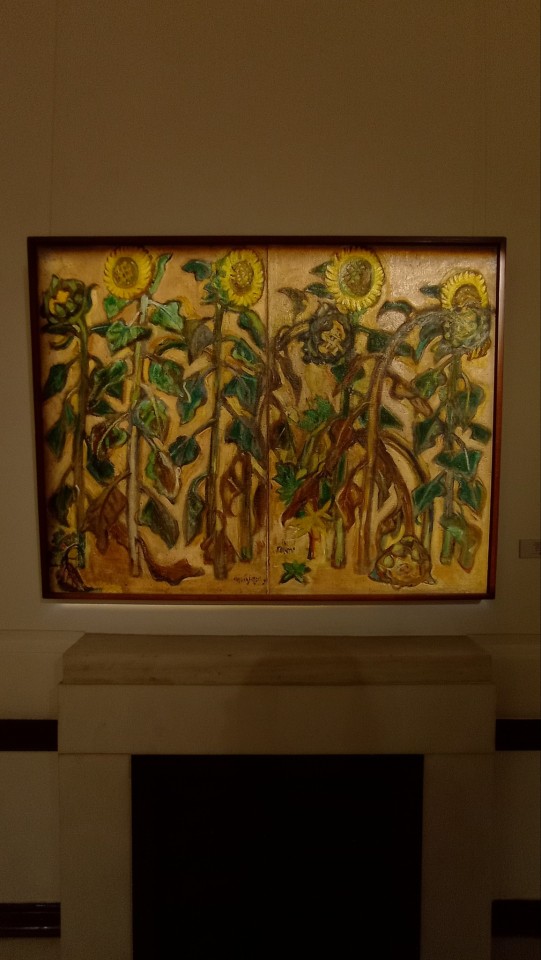

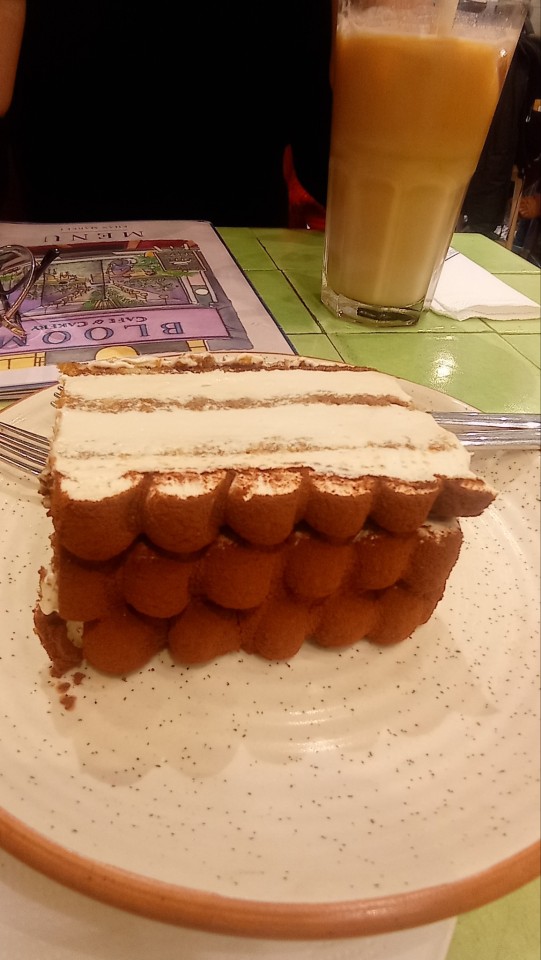
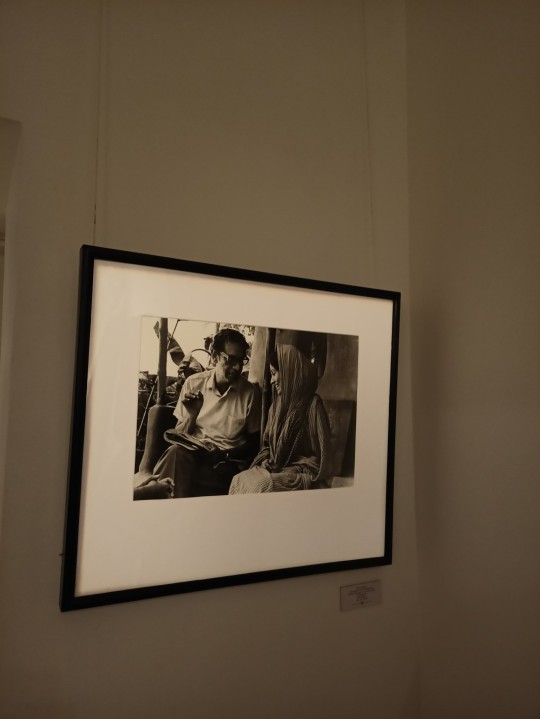


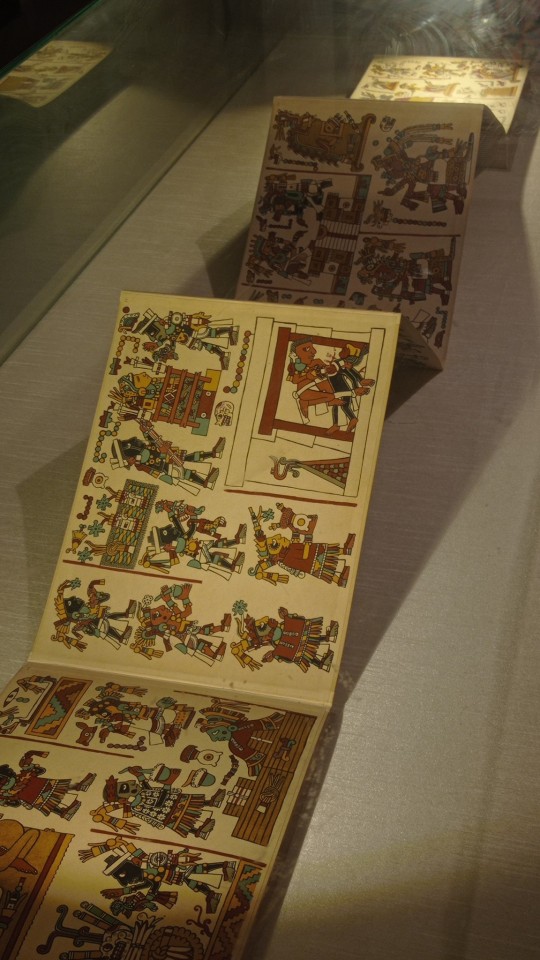
from my gallery (30/12/2023) - museum & cafe date with best friend <3
#national gallery of modern art#new delhi#museums#indian museums#dark academia#dark academia aesthetic#aesthetic#classic academia#classic academia aesthetic#light academia#light acadamia aesthetic#academia#moodboard#nostalgia#desi#being desi#tiramisu#coffee#cappuccino#visual art#graphic art#art history#artwork#art#art museum#chaotic academia#history#gallery#art gallery#mine
96 notes
·
View notes
Text

Self-portrait (1930) by Amrita Sher-Gil. National Gallery of Modern Art, New Delhi.
#amrita sher gil#national gallery of modern art#india#indian artist#indian painter#female painter#female artist#20th century art#20th century#hungarian art#hungarian painter#europe#modernism#modernist art#modernist painter#new delhi
0 notes
Text

Amrita Sher-Gil, Self-Portrait, 1930
oil on canvas, 49 x 65.5 cm. (19.29 x 25.79 in.)
National Gallery of Modern Art, New Delhi, India
77 notes
·
View notes
Photo

From “Little Ladies Museum”, Dayanita Singh.
Dayanita Singh was born in New Delhi in 1961 and studied at the National Institute of Design in Ahmedabad and the International Center of Photography in New York. Her work has been exhibited at institutions including the Museum of Modern Art, New York; Tate Modern, London; the Art Institute of Chicago; Hayward Gallery, London; the Kiran Nadar Museum of Art, New Delhi; and the Tokyo Photographic Art Museum. In 2013 she represented Germany at the Venice Biennale. Bookmaking is central to Singh’s practice.
Her books with Steidl include Privacy (2004), Chairs (2005), Go Away Closer (2007), Sent a Letter (2007), Dream Villa (2010), File Room (2013), Museum of Chance (2014), Museum Bhavan (2017)—Book of the Year at the 2017 Paris Photo–Aperture Foundation Photobook Awards and winner of the 2018 ICP Infinity Award for Artist’s Book—and Zakir Hussain Maquette (2019). Singh is the 2022 Hasselblad Award recipient.
10 notes
·
View notes
Photo

See that Sher-Gil, watch that scene
Amrita Sher-Gil, Group of Three Girls, 1935, National Gallery of Modern Art, New Delhi
#art history#art history memes#art meme#dad jokes#puns#punny#punsarelikeonions#women artists#women in art#womens history month#Amrita Sher-Gil
5 notes
·
View notes
Text
The Vibrant Canvas: Exploring Visual Arts in Delhi
Delhi, the capital city of India, is not only renowned for its rich historical and cultural heritage, but it also boasts a thriving and diverse Visual Arts scene. From ancient murals and traditional crafts to contemporary galleries and cutting-edge exhibitions, Delhi provides a fascinating tapestry of visual art forms that captivate both locals and tourists alike. In this article, we will delve into the vibrant world of visual arts in Delhi, exploring its historical roots, modern expressions, and the platforms that contribute to its continual evolution.

Historical Legacy:
Delhi’s visual arts legacy is deeply intertwined with its historical journey. The city’s monumental architecture, spanning from the Qutub Minar to the Red Fort, serves as a testament to the artistic prowess of various dynasties that ruled the region. Intricate Mughal frescoes and exquisite Persian-style miniatures tell stories of an era long gone by, showcasing the melding of cultures that shaped Delhi’s identity. The Humayun’s Tomb complex, a UNESCO World Heritage Site, stands as an exemplar of Mughal garden design and architectural elegance.
Traditional Crafts and Artistry:
Delhi’s cultural landscape is enriched by a myriad of traditional crafts and art forms that have been passed down through generations. The bustling lanes of Old Delhi are home to bustling bazaars where artisans skillfully create mesmerizing textiles, intricate jewelry, and stunning pottery. The art of Zardozi, the elaborate embroidery technique, and Meenakari, the enameling tradition, continue to thrive, connecting the past with the present.
Contemporary Galleries and Exhibitions:
As the city has evolved, so too has its visual arts scene. Modern Delhi is a hub for contemporary galleries and exhibition spaces that showcase the cutting-edge works of emerging and established artists. The National Gallery of Modern Art (NGMA) serves as a repository of Indian modern art, featuring a diverse collection of paintings, sculptures, and installations that reflect the changing socio-political landscape. Prominent galleries like the Kiran Nadar Museum of Art and the Devi Art Foundation provide platforms for experimental art forms and interdisciplinary collaborations.
Street Art and Urban Expression:
Delhi’s streets have become a canvas for street artists who use public spaces to express their creativity and engage with the public. Graffiti, murals, and installations adorn walls, bridges, and alleyways, transforming mundane surroundings into vibrant visual narratives. The Lodhi Art District, a street art initiative, has breathed new life into the Lodhi Colony area, turning it into an open-air gallery where local and international artists converge to create captivating murals.
Art Festivals and Cultural Events:
The city’s cultural calendar is punctuated by numerous art festivals and events that celebrate the visual arts. The India Art Fair, a prestigious annual event, brings together galleries, collectors, and artists from around the world, offering a comprehensive overview of contemporary art trends. The Delhi International Arts Festival showcases a diverse range of art forms, including visual arts, dance, music, and theater, fostering cross-cultural interactions and creative exchange.
Preserving Heritage and Fostering Innovation:
While embracing its historical heritage, Delhi also encourages innovation and experimentation in the visual arts. The Sanskriti Kendra, an artist residency program, provides a nurturing environment for artists to engage with traditional crafts and techniques while exploring new directions. Institutes like the College of Art and the Jamia Millia Islamia’s Faculty of Fine Arts play a pivotal role in nurturing young talents and encouraging artistic exploration
Delhi’s visual arts landscape is a dynamic interplay of tradition and modernity, where ancient artistry harmoniously coexists with contemporary expressions. The city’s historical legacy, vibrant traditional crafts, flourishing galleries, street art movement, and cultural events collectively contribute to its thriving visual arts scene. As Delhi continues to evolve, it remains a hub of creative energy, offering a visual feast that reflects the diverse and ever-changing cultural tapestry of the city.
2 notes
·
View notes
Text

Immersing in Cultural Riches: A Tour Through India’s Iconic Museums
by Team ACF 0 comment
Introduction:
India, a land steeped in history, mythology, and diverse cultural traditions, boasts an array of museums that showcase the nation’s rich heritage. From ancient artifacts to modern masterpieces, these institutions offer a fascinating journey through time. Let’s explore some of the most famous museums in India, where each exhibit is a testament to the country’s vibrant and multifaceted past.
The Indian Museum, Kolkata: Established in 1814, the Indian Museum in Kolkata is one of the oldest and largest museums in India. Its extensive collection spans natural history, art, and anthropology, housing artifacts from the country’s various regions. The Egyptian mummies, the Ashoka Pillar, and the ancient sculptures are among the many treasures that make this museum a must-visit.
The National Museum, New Delhi: The National Museum stands as a custodian of India’s cultural heritage, showcasing a vast array of artifacts from different eras. From Harappan Civilization relics to Mughal paintings, the museum provides a comprehensive overview of India’s history. The highlight is the exquisite collection of sculptures, including the famous Dancing Girl from Mohenjo-daro.
Chhatrapati Shivaji Maharaj Vastu Sangrahalaya (CSMVS), Mumbai: Formerly known as the Prince of Wales Museum, CSMVS is an architectural gem in Mumbai. The museum boasts an extensive collection of art, archaeology, and natural history, with artifacts ranging from ancient Indus Valley relics to intricate miniature paintings. Its impressive collection of decorative arts and historic artifacts offers a glimpse into India’s royal past.
Salar Jung Museum, Hyderabad: The Salar Jung Museum is a treasure trove of art and antiques amassed by the Salar Jung family. Housed in a grand palace, the museum features a diverse collection, including rare manuscripts, sculptures, textiles, and an intriguing collection of clocks. The world-famous “Veiled Rebecca” sculpture and the “Double Statue” are among its prized possessions.
National Gallery of Modern Art (NGMA), New Delhi: For enthusiasts of contemporary art, the National Gallery of Modern Art in New Delhi is a haven. Showcasing a stellar collection of modern and contemporary Indian art, the museum features works by renowned artists like Raja Ravi Varma, Rabindranath Tagore, and contemporary stalwarts. Regular exhibitions keep the space dynamic and reflective of India’s evolving art scene.
Dr. Bhau Daji Lad Museum, Mumbai: Nestled in the heart of Mumbai, this museum is the oldest in the city and showcases the decorative and industrial arts of the 19th-century. The museum’s architecture itself is a marvel, and its collection includes intricate pottery, textiles, and maps that provide a glimpse into Mumbai’s cultural evolution.
Conclusion:
India’s museums stand as guardians of its rich cultural tapestry, inviting visitors to embark on a journey through time and diverse artistic expressions. From the ancient artifacts that whisper tales of civilizations past to the contemporary canvases that reflect the pulse of modern India, each museum holds a unique key to understanding the nation’s heritage. As these cultural repositories continue to evolve, they remain vital spaces where the past, present, and future intersect, preserving the essence of India’s artistic and historical legacy.
0 notes
Text
Top Benefits of Investing in Flats for Sale in Gurgaon

Gurgaon has rapidly transformed into one of India’s most sought-after real estate markets. Known for its towering skyscrapers, world-class infrastructure, and proximity to key commercial hubs, Gurgaon offers an attractive destination for homebuyers and investors alike. Investing in flats for sale in this bustling city comes with a range of benefits, making it a smart choice for those looking to secure a home or a valuable asset. Here are some of the top reasons why investing in flats for sale in Gurgaon is a wise decision.
1. Strategic Location and Connectivity
One of the most significant advantages of investing in a flat in Gurgaon is its strategic location. Gurgaon enjoys excellent connectivity to Delhi, Noida, and other parts of the National Capital Region (NCR). The city is well-connected via major highways like the Delhi-Gurgaon Expressway, NH-48, and the upcoming Dwarka Expressway, which further enhances accessibility. The extensive metro network and proximity to the Indira Gandhi International Airport make commuting effortless, offering unparalleled convenience for residents.
2. Thriving Commercial Hub
Gurgaon is a leading business hub, home to numerous multinational corporations, IT parks, and start-ups. The city has earned a reputation as the "Millennium City" due to its flourishing corporate landscape. Investing in a flat in Gurgaon places you close to major business centers, significantly reducing commute times for working professionals. This has made the city an attractive option for both property investors and end-users, as there is always a strong demand for homes near commercial areas.
3. World-Class Infrastructure
Gurgaon boasts exceptional infrastructure, including wide roads, planned residential communities, and premium amenities. The city’s rapid urbanization has resulted in the development of modern residential complexes with facilities like parks, gyms, swimming pools, and children’s play areas. These state-of-the-art residential projects are designed to offer residents a comfortable and luxurious lifestyle, ensuring a high quality of life for families, young professionals, and retirees alike.
4. High Return on Investment
The real estate market in Gurgaon has consistently shown strong appreciation in property value. Given its steady growth and increasing demand for premium housing, flats in Gurgaon offer great potential for long-term investment. Whether you're planning to buy a home to live in or looking for a property that will generate rental income, Gurgaon is a market that can deliver excellent returns. The city's constant development of commercial, retail, and leisure spaces contributes to the rising property values, ensuring a stable and profitable investment.
5. Diverse Range of Housing Options
Gurgaon offers a wide array of residential options, from compact apartments to sprawling luxury flats. Whether you're seeking a home that offers urban convenience or a gated community with top-notch security and amenities, Gurgaon has something for everyone. Many new projects focus on sustainable living, offering green spaces, energy-efficient homes, and eco-friendly infrastructure. This diversity allows homebuyers to find a property that fits their lifestyle and long-term needs.
6. A Booming Social and Cultural Scene
Gurgaon is not just about work; it's also a city that offers a vibrant social life. From high-end shopping malls, multiplexes, and fine dining restaurants to cultural events, art galleries, and entertainment hubs, the city caters to those who enjoy an active lifestyle. For families, Gurgaon is home to some of the best schools, healthcare facilities, and recreational spaces in the country. The thriving social scene makes living in Gurgaon both enjoyable and enriching, enhancing the overall appeal for homebuyers.
7. Safe and Secure Residential Communities
Safety is a top priority for homebuyers, and Gurgaon’s gated communities provide a secure environment for families. Many residential projects are equipped with 24/7 security services, CCTV surveillance, and controlled access points, ensuring peace of mind for residents. This focus on safety makes Gurgaon a prime location for families with children and individuals looking for a secure place to call home.
8. Proximity to Educational and Healthcare Institutions
Gurgaon is known for its excellent educational institutions and world-class healthcare facilities. Top schools, universities, and international schools are located throughout the city, offering a wide range of options for families with children. Additionally, Gurgaon’s proximity to renowned hospitals and medical centers ensures that residents have access to the best healthcare services whenever needed. This convenience makes it an appealing destination for those looking to settle in a well-rounded and future-ready city.
9. Future Growth Prospects
Gurgaon’s future looks promising, with ongoing infrastructure projects and development plans that will further enhance the city’s appeal. The upcoming metro expansions, improved road networks, and new commercial and retail spaces are set to boost the city’s growth even further. By investing in a flat in Gurgaon now, homebuyers can take advantage of the city’s long-term potential and be part of a city that continues to evolve and thrive.
Conclusion
Investing in flats for sale in Gurgaon offers a myriad of benefits, from excellent connectivity and thriving commercial centers to world-class infrastructure and high returns. Whether you’re looking for a home that supports your lifestyle or an investment that promises future growth, Gurgaon is a city that delivers on every front. With its vibrant social scene, safe communities, and endless opportunities, Gurgaon is the ideal destination for those seeking a better, more fulfilling life.
1 note
·
View note
Text
Top Must-Visit Spots for Local Sightseeing in Delhi
Delhi is the capital city of India which gets lakhs of tourists or visitors every day. It was the ancient capital as well due to which this city has a blend of everything. You can get ancient stalls to modern cafes which suit all groups. So say "Delhi hai dilwalon ki" and start your tour by booking cabs for comfortable local sightseeing in Delhi. The cab service will let you transfer around the -city with ease. You can travel like a local in this beautiful capital city of India.
Jama Masjid
The Jama Masjid is the largest mosque in India. It has high minarets that give great views of Old Delhi's winding streets and red fort. You can climb the minarets with a guide to see the bustling chowks below. Emperor Shah Jahan built this mosque from red sandstone and white marble.

Rashtrapati Bhavan
Rashtrapati Bhavan is the official home of India's President. The huge palace has beautiful Mughal-style gardens with fountains and pools. The buildings mix Indian and Western architectural designs. You can take guided tours showing the palace's library, state rooms and residences. The changing of the guard ceremony is a highlight.
Agrasen Ki Baoli
The Agrasen Ki Baoli is an ancient stepwell right in New Delhi. You can walk down the narrow stone steps to find groundwater. This place attracts photographers and history lovers. The steps and pools create a quiet and mystical mood. This makes it a unique site for Delhi explorers.
National Museum
The National Museum in Delhi houses over 200,000 Indian artworks and artefacts. You can visit to take an incredible 5,000-year journey through Indian history. You can see ancient sculptures, Mughal miniatures, intricate manuscripts and much more. The Buddhist art section and the jewellery gallery are quite stunning. For art and culture lovers, the National Museum is a must-include among Delhi attractions.
Safdarjung Tomb
Safdarjung Tomb is a peaceful garden tomb in Delhi built in the Mughal style. You can visit its marble and red sandstone buildings. Safdarjung Tomb sees fewer crowds than Humayun's Tomb yet has similar grandeur. The jali patterns allow light inside to play beautifully in the tomb.
Sarojini Nagar Market
Sarojini Market is a famous street market selling trendy clothes and goods. Both tourists and locals hunt for deals at its small shops and stalls. You go there to buy colourful salwar suits, scarves, bags, and funky accessories priced affordably. You can try local snacks like chaat papri and chole bhature. For shopping in Delhi on a budget, Sarojini Nagar Market shouldn't be missed.
Hauz Khas Village
Hauz Khas Village is an urban neighbourhood with medieval ruins and modern attractions. The remains of 14th-century Islamic buildings surround a pretty lake. Now Hauz Khas has art galleries, designer boutiques, cafes and bars too. The mix of history and cosmopolitan energy makes this a trendy place to explore and hang out in Delhi.
Tughlaqabad Fort
You can visit Tughlaqabad to see the well-preserved ruins of a tough 14th-century citadel. The massive red sandstone walls, crumbling palaces, and twisting lanes let you imagine life centuries ago. Sultan Ghiyas-ud-din Tughlaq built it but didn't rule here long. The scenic Aravalli hills and lakes encircling Tughlaqabad Fort add to its photogenic beauty.
So contact a cab rental company today for your upcoming Delhi local sightseeing. Cab Service in Delhi NCR with ChikuCab Enjoy a comfortable and hassle-free journey while taking in the rich history and vibrant culture of Delhi.
0 notes
Text
Field Trips and Educational Tours in Chennai’s International Schools

Field trips and educational tours are integral components of the learning experience in international schools in Chennai. These excursions provide students with opportunities to extend their learning beyond the classroom, fostering a deeper understanding of various subjects and helping them connect theoretical knowledge with real-world applications.
Explore the best international schools in Chennai, offering world-class education, diverse curricula, and enriching extracurricular activities, ensuring holistic development for students in a global learning environment."
Importance of Field Trips and Educational Tours
Experiential Learning:
Field trips offer hands-on learning experiences, allowing students to engage with the material in a practical context. For example, a visit to the Dakshinachitra Museum can bring history lessons to life by showcasing traditional South Indian homes and crafts, while a trip to the Guindy National Park can enhance biology lessons by exposing students to local flora and fauna.
Cultural Exposure:
Educational tours to historical sites like Mahabalipuram or Fort St. George provide students with a rich cultural experience. These trips help students understand the region’s heritage, art, and architecture, fostering an appreciation for diverse cultures and histories.
Interdisciplinary Learning:
Many international schools in Chennai integrate interdisciplinary themes into their field trips. For instance, a visit to the Madras High Court could combine elements of history, political science, and law, giving students a well-rounded perspective on how different disciplines intersect in the real world.
Environmental Awareness:
Environmental education is a key focus in many international schools, and field trips to locations like Muttukadu Backwaters or Arignar Anna Zoological Park at Vandalur serve to raise awareness about conservation and sustainability. These trips often include activities such as bird watching, nature walks, and discussions on biodiversity, helping students develop a sense of responsibility towards the environment.
Global Connections:
International schools often emphasize global awareness, and educational tours can include trips to places with international significance. For example, visits to consulates, international organizations, or participating in Model United Nations (MUN) conferences in cities like New Delhi or Singapore can broaden students' understanding of global issues and international relations.
Examples of Field Trips and Educational Tours
Science and Technology:
Schools frequently organize visits to institutions like the Birla Planetarium or the Institute for Mathematical Sciences to enhance students’ understanding of scientific concepts. These trips provide interactive experiences that make complex topics more accessible and engaging.
Art and Creativity:
Visits to art galleries such as the Cholamandal Artists' Village offer students a chance to explore contemporary Indian art. These excursions often include workshops where students can try their hand at various artistic techniques, encouraging creative expression.
Industry and Economics:
Industrial visits are also popular, with trips to factories or IT companies like TCS or Cognizant in Chennai's tech parks. These tours offer insights into the corporate world, supply chain management, and the impact of technology on modern economies, providing students with a preview of potential career paths.
Social Responsibility:
Many international schools organize visits to NGOs, orphanages, or rural areas, aiming to inculcate a sense of social responsibility among students. These experiences encourage empathy, social awareness, and the importance of community service.
Benefits for Students
Enhanced Learning Outcomes:
Field trips help reinforce classroom learning by providing tangible experiences. This often leads to better retention of information and a deeper understanding of the subject matter.
Personal Growth:
These experiences promote personal growth, encouraging students to step out of their comfort zones, interact with new environments, and develop critical thinking and problem-solving skills.
Building Social Skills:
Traveling together on educational tours fosters teamwork and cooperation among students. It also provides opportunities for them to build friendships and improve their communication skills in diverse settings.
Inspiration and Motivation:
Field trips often inspire students to explore new interests and passions. Whether it’s a newfound love for nature after a visit to a national park or a curiosity about history sparked by a trip to a museum, these experiences can shape future academic and career choices.
Conclusion
Field trips and educational tours in Chennai’s international schools play a crucial role in providing a well-rounded education. By exposing students to new experiences, cultures, and knowledge, these excursions not only complement the academic curriculum but also contribute to the holistic development of students, preparing them to become informed and responsible global citizens.
#international schools in chennai#best international schools in chennai#top 10 international schools in chennai
0 notes
Text

Bride's Toilet (1937) by Amrita Sher-Gil. National Gallery of Modern Art, India.
#amrita sher gil#national gallery of modern art#india#indian artist#indian painter#female painter#female artist#20th century art#20th century#hungarian art#hungarian painter#europe#modernism#modernist art#modernist painter#new delhi
0 notes
Text
How To Spend A Luxurious Weekend In New Delhi

Spending a luxurious weekend in New Delhi can be a delightful experience filled with fine dining, cultural visits, and indulgent relaxation. Start your day with a lavish breakfast at one of the city's five star hotels, such as The Oberoi or The Leela Palace. Afterward, visit the National Gallery of Modern Art or the India Habitat Centre for a dose of culture and art.
For lunch, consider dining at a high end restaurant like Indian Accent or Bukhara, known for their exquisite cuisine. In the afternoon, treat yourself to a spa session at the Kaya Kalp or The Imperial Spa, where you can unwind and rejuvenate
As evening approaches, enjoy a cocktail at a rooftop bar, such as the Sky Lounge at the Royal Plaza, offering panoramic views of the city. Finally, end your day with a gourmet dinner at a renowned restaurant, ensuring a truly luxurious weekend in the heart of New Delhi.
if want to visit delhi historical places book a Luxury Van on Rent in Delhi for a comfortable trip. who makes your trip luxurious.
0 notes
Text
Indoor Places to Visit in Delhi

Delhi has many interesting indoor places for visitors who want to learn about the city's culture, history and art.
National Museum-The National Museum is in New Delhi on a street called Janpath. It is a big building full of ancient and important things from India. You can see very old objects from ancient cities, small detailed paintings from the time of Mughal kings, and special items connected to the Buddha.
National Gallery of Modern Art (NGMA)- The National Gallery of Modern Art is close to India Gate. It shows lots of new and current Indian art. You can see paintings by famous artists like Amrita Sher-Gil and Raja Ravi Varma there. It is a big collection of modern Indian artwork.
Gurudwara Bangla Sahib- Gurudwara Bangla Sahib is an important Sikh temple in Delhi. It is not just for prayer, but also has a great history. The peaceful pond and free community kitchen are special features. Many people visit to see its beauty and learn about Sikh culture.
Dilli Haat- Dilli Haat is a special market in Delhi, India. It is a covered place where you can buy handmade items clothes and food from all over India. It is in an area INA and gives shoppers a fun and different experience.
Lotus Temple The Lotus Temple in Delhi is a beautiful building that looks like a big flower. It is a special place for Bahá'í people to pray. Inside, it is quiet and perfect for thinking or relaxing.
Book a 25 Seater Tempo Traveller for an enjoyable journey. Enjoy spacious seating, air conditioning and reliable service.
#indoorplaces#placestovisitindelhi#25seatertempotraveller#tempotravelleronrent#tempotraveller#carhireindelhi
0 notes
Text
Exploring the Pinnacle of Indian Architecture: The Best Architects in India
India, with its rich heritage and rapidly modernizing cities, has become a canvas for architectural innovation. The country boasts some of the best Indian architects who have left their mark with iconic designs and sustainable structures. At Design Forum International, we celebrate these trailblazers who have shaped the architectural landscape of India. Here’s a deep dive into the top architects in India, their philosophies, and their most notable works.

1. Hafeez Contractor: The Visionary Innovator
Hafeez Contractor is one of the most well-known names in Indian architecture. With a career spanning over four decades, he has designed numerous landmark projects across the country. Contractor's work ranges from residential buildings and commercial spaces to educational institutions and airports.
Notable Projects:
Imperial Towers, Mumbai: These twin residential skyscrapers are among the tallest buildings in India, reflecting Contractor's penchant for high-rise design.
DY Patil Stadium, Navi Mumbai: A state-of-the-art cricket stadium that showcases his versatility and understanding of large-scale infrastructure projects.
2. B.V. Doshi: The Pritzker Laureate
Balkrishna Vithaldas Doshi, the first Indian architect to receive the prestigious Pritzker Architecture Prize, is renowned for his sustainable and humane design approach. Doshi's work emphasizes the use of local materials and traditional methods, creating spaces that are in harmony with their surroundings.
Notable Projects:
Indian Institute of Management, Bangalore: A campus that blends modernist design with traditional Indian elements, fostering an environment conducive to learning and innovation.
Aranya Low-Cost Housing, Indore: This project exemplifies Doshi's commitment to social architecture, providing affordable housing solutions without compromising on aesthetics or functionality.
3. Charles Correa: The Master Planner
Charles Correa was an architect and urban planner whose contributions have significantly shaped contemporary Indian architecture. Correa's designs are characterized by their responsiveness to the climate, culture, and needs of the people.
Notable Projects:
Kanchenjunga Apartments, Mumbai: A residential high-rise that cleverly integrates cross-ventilation and open spaces, offering a modern living experience while mitigating the harsh tropical climate.
Jawahar Kala Kendra, Jaipur: A cultural center that draws inspiration from traditional Indian architectural principles and cosmic geometry, creating a space that resonates with the local heritage.
4. Raj Rewal: The Structural Artist
Raj Rewal's architecture is marked by a deep understanding of structural engineering and an artistic approach to design. His projects often feature bold geometries and innovative use of materials.
Notable Projects:
Hall of Nations, New Delhi: Although recently demolished, this iconic structure was celebrated for its futuristic design and was a testament to Rewal's vision and technical prowess.
Asian Games Village, New Delhi: Designed for the 1982 Asian Games, this residential complex reflects Rewal's expertise in creating livable, community-focused spaces.
5. Sanjay Puri: The Modernist Maestro
Sanjay Puri is a contemporary architect whose work is characterized by its striking forms and dynamic designs. Puri's projects often incorporate bold, fluid lines and vibrant colors, making them stand out in any urban landscape.
Notable Projects:
Bombay Arts Society, Mumbai: A building that challenges conventional design norms with its fluid, sculptural form, housing galleries, and artist studios.
The Courtyards House, Rajasthan: A residential project that combines traditional Rajasthani courtyard planning with modern aesthetics, creating a unique fusion of old and new.
Why Choose Design Forum International?
At Design Forum International, we are inspired by these stalwarts of Indian architecture. Our team comprises some of the top Indian architects who bring their unique perspectives and expertise to every project. Here’s why you should consider us for your architectural needs:
Innovative Designs: We believe in pushing the boundaries of conventional design to create spaces that are both functional and aesthetically pleasing.
Sustainable Practices: Our commitment to sustainability ensures that our projects minimize environmental impact and promote green living.
Client-Centric Approach: We prioritize our clients' needs and visions, ensuring that every project is a true reflection of their aspirations.
Comprehensive Services: From conceptualization and design to project management and execution, we offer end-to-end architectural solutions.
Conclusion
India's architectural landscape is rich and diverse, thanks to the contributions of its best architects. At Design Forum International, we strive to uphold this legacy by delivering cutting-edge designs and sustainable solutions. Whether you’re looking to build a residential masterpiece or a commercial landmark, our team of top architects in India is here to bring your vision to life.
Contact Design Forum International today and let us help you create the space of your dreams, inspired by the best Indian architects.
1 note
·
View note
Text
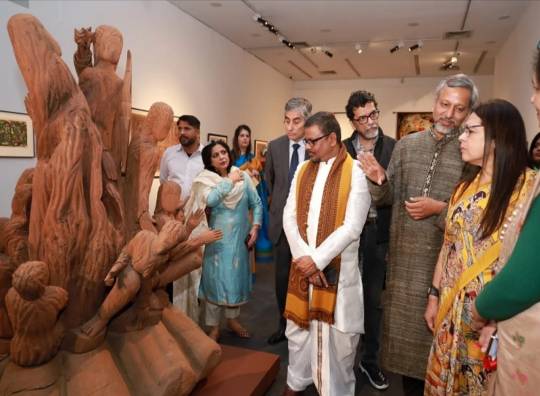
Sri Ram Vijay (Divine Victory), a wooden sculpture by renowned sculptor Neeraj Gupta, is on display from March 1 to April 30 at the National Gallery of Modern Art, New Delhi as part of the "Ramayan Chitra Kavyam" exhibition.
https://www.brutimes.com/news/art-culture/sri-ram-vijay-a-timeless-depiction-of-ram-and-sita-by-neeraj-gupta
#neeraj gupta#divine victory#Jai Sri Ram#Sri Ram Vijay#National Gallery of Modern Art#sculpture artist
0 notes